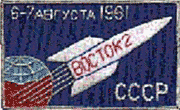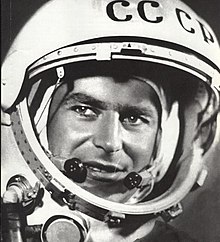 Model of the Vostok capsule with its upper stage | |
| Operator | Soviet space program |
|---|---|
| Harvard designation | 1961 Tau 1 |
| COSPAR ID | 1961-019A |
| SATCAT no. | 168 |
| Mission duration | 1 day, 1 hour, 18 minutes[1] |
| Orbits completed | 17.5 |
| Spacecraft properties | |
| Spacecraft | Vostok-3KA No.4 |
| Manufacturer | Experimental Design OKB-1 |
| Launch mass | 4,731 kilograms (10,430 lb)[1] |
| Crew | |
| Crew size | 1 |
| Members | Gherman Titov |
| Callsign | Орёл (Oryol - "Eagle")[2] |
| Start of mission | |
| Launch date | August 6, 1961, 06:00 UTC |
| Rocket | Vostok-K 8K72K |
| Launch site | Baikonur 1/5[3] |
| End of mission | |
| Landing date | August 7, 1961, 07:18 UTC |
| Landing site | Krasny Kut 50°51′10″N 47°01′14″E / 50.85276°N 47.02048°E[4] |
| Orbital parameters | |
| Reference system | Geocentric |
| Regime | Low Earth |
| Eccentricity | 0.00501 |
| Perigee altitude | 166 kilometres (103 mi) |
| Apogee altitude | 232 kilometres (144 mi)[5] |
| Inclination | 64.93 degrees |
| Period | 88.46 minutes |
| Epoch | 6 August 1961, 02:00:00 UTC[6] |

 | |
Vostok 2 (Russian: Восток-2, Orient 2 or East 2) was a Soviet space mission which carried cosmonaut Gherman Titov into orbit for a full day on August 6, 1961, to study the effects of a more prolonged period of weightlessness on the human body.[1] Titov orbited the Earth over 17 times, exceeding the single orbit of Yuri Gagarin on Vostok 1 − as well as the suborbital spaceflights of American astronauts Alan Shepard and Gus Grissom aboard their respective Mercury-Redstone 3 and 4 missions. Titov's number of orbits and flight time would not be surpassed by an American astronaut until Gordon Cooper's Mercury-Atlas 9 spaceflight in May 1963.
After the flight of Vostok 1, Sergei Korolev took a short vacation in Crimea where he began working out the flight plan for the next mission. There were considerable arguments over the duration of the mission as flight doctors argued for no more than three orbits. The flight of Korabl-Sputnik 2 nine months earlier had carried two dogs on a six orbit mission, during which the animals had experienced convulsions and thus all subsequent Vostok missions were limited to three orbits maximum. Although dogs and humans were very different physiologically, the doctors were worried about the risks posed on a longer flight. There was also the purely practical aspect of spacecraft recovery. If Vostok 2 flew three orbits, reentry and landing would take place in the wide open steppes of southern Russia, the landing site moving steadily further west with each orbit. Orbits 8-13 would drop the capsule into the Pacific Ocean, after which landing would again occur in Soviet territory, but in the remote, frozen wastes of Siberia. Thus, it was necessary to spend a full 24 hours in space before it would be once again possible to land in the prime recovery area in southern Russia. The three orbit limit thus would not only make landing easy, but minimize risks to the cosmonaut posed by prolonged weightlessness.
Korolev argued that since it would still take an entire day for landing in southern Russia to be possible again, there was no reason not to go for it. Besides, he argued, missions of the future would inevitably require lengthy stays in space. The flight was targeted for somewhere between July 25 and August 5. To ensure safe radiation levels, balloons equipped with Geiger counters were flown aloft; in addition, similar equipment would be carried on Vostok 2. Several enhancements were made to Vostok 2, including an improved TV transmission system and better climate control systems.
Liftoff took place August 6 at 8:57 AM Moscow time and booster performance was almost flawless, placing the spacecraft into a 184x244 km orbit.
The flight was an almost complete success, marred only by a heater that had inadvertently been turned off prior to liftoff and that allowed the inside temperature to drop to 50 °F (10 °C),[7]: 113 a bout of space sickness, and a troublesome re-entry when the reentry module failed to separate cleanly from its service module.[8]
Unlike Yuri Gagarin on Vostok 1, Titov took manual control of the spacecraft for a short while. Another change came when the Soviets admitted that Titov did not land with his spacecraft. Titov would claim in an interview that he ejected from his capsule as a test of an alternative landing system; it is now known that all Vostok program landings were performed this way.[1][9]
The re-entry capsule was destroyed during development of the Voskhod spacecraft.[7]: 117
Titov was a month short of 26 years old at launch. He was the youngest person to reach space until the launch of Blue Origin NS-16 in 2021.[10][11] He remains the youngest person to orbit the Earth.
- ^ a b c d "The First Day In Orbit". Flight. 80 (2736). London: Iliffe Transport Publications: 208. 17 August 1961. Archived from the original (PDF) on 2019-06-03. Retrieved 2009-03-12.
- ^ Yenne, Bill (1988). The Pictorial History of World Spaceflight. Exeter. p. 18. ISBN 0-7917-0188-3.
- ^ "Baikonur LC1". Encyclopedia Astronautica. Archived from the original on 2009-04-15. Retrieved 2009-03-04.
- ^ "Google Maps - Vostok 2 Landing Site - Monument". Archived from the original on 2022-04-06. Retrieved 2010-12-25.
- ^ "Missiles and Spaceflight" (PDF). Flight. 80 (2741). London: Iliffe Transport Publications: 467. 21 September 1961. Archived from the original on 2019-06-03. Retrieved 2009-03-12.
- ^ "NASA - NSSDCA - Spacecraft - Trajectory Details". nssdc.gsfc.nasa.gov. Archived from the original on 2020-06-09. Retrieved 2018-05-02.
- ^ a b Francis French; Colin Burgess (2007). Into That Silent Sea: Trailblazers of the Space Era, 1961-1965. Lincoln, Nebr.: University of Nebraska Press. ISBN 978-0-8032-1146-9. OCLC 71210133.
{{cite book}}: CS1 maint: multiple names: authors list (link) - ^ Grahn, Sven. "The flight of Vostok-2". Sven's Space Place. Archived from the original on 2008-12-08. Retrieved 2009-03-12.
- ^ Ezell, Edward Clinton; Ezell, Linda Neuman (1978). "The Partnership: A History of the Apollo-Soyuz Test Project". NASA History Series (NASA Special Publication-4209). NASA. Archived from the original on 2007-08-23. Retrieved 2009-03-17.
- ^ Wade, Mark. "Astronaut Statistics". Encyclopedia Astronautica. Archived from the original on 2007-09-30. Retrieved 2009-03-12.
- ^ Foust, Jeff (20 July 2021). "Blue Origin launches Bezos on first crewed New Shepard flight". SpaceNews. Archived from the original on 1 October 2021. Retrieved 20 Jul 2021.